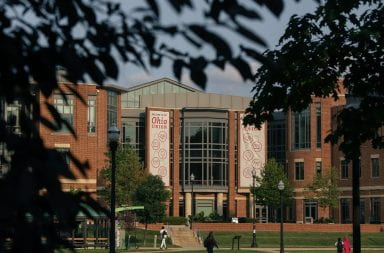
Darryl Hood is the faculty co-chair of the Diversity, Equity and Inclusive Excellence committee
in the College of Public Health. Credit: Christian Harsa | Asst. Photo Editor
Darryl Hood launched his fight for racial equity at only 8 years old.
Hood was a plaintiff in Swann v. Charlotte-Mecklenburg Board of Education, the 1971 landmark Supreme Court case that upheld busing — a process where school buses were desegregated and transported Black and Latino students to white schools and white students to predominantly minority schools. Today, as a professor in the Division of Environmental Health Sciences in the College of Public Health, Hood applies his experiences in an effort to make diversity a culture at Ohio State.
“Diversity and inclusion, inclusive excellence, is a culture. And it takes a while to develop such a culture,” Hood said.
Hood earned his undergraduate degree at Johnson C. Smith University before continuing on to a doctorate program at East Tennessee State University and completing a postdoc at Vanderbilt University.
Unlike Johnson C. Smith University, a historically Black university, East Tennessee and Vanderbilt were predominantly white institutions. In his transition from an HBCU to predominantly white institutions such as ETSU and Vanderbilt, he said he became aware of the issues facing minorities at majority institutions and developed the skills to address them at Ohio State.
One key issue was the perception of diversity and inclusion at predominantly white institutions. At these universities, including Ohio State, he said diversity and inclusion are often viewed as an activity, rather than as a culture.
Hood serves as the faculty co-chair of the Diversity, Equity and Inclusive Excellence committee in the College of Public Health. He said he has taken on the role of educating majority faculty, which is often the case for Black faculty working on diversity initiatives. However, he said it’s somewhat of a thankless service.
‘Of course Black faculty (are) always put on diversity committees,” Hood said. ”There’s literature out there that indicate that that’s not so good for that particular faculty member.”
Still, Hood said he sees it as his role to help educate others at Ohio State. He follows in the footsteps of his parents, who were civil rights activists. His father, a Presbyterian minister, marched with Martin Luther King in the 1960s.
“I bring that type of perspective to Ohio State, and that’s how I see my role,” Hood said.
In addition to his teaching responsibilities at Ohio State, Hood serves as a mentor to underrepresented students at the university.
He said he suspects that it will be difficult for current undergraduate students to advance to graduate school, postdoctoral and tenure track faculty positions when they do not see themselves represented in the racial demographic at the institution.
“There are profound feelings of isolationism when Black faculty come into an environment like a college or school at OSU,” he said.
That’s why when he progressed through his education, he established a “blue sky group” — a network of individuals he turned to for support with his life and career.
“Anyone that came up during the last 30 years has an umbrella of individuals that they can go to for advice,” Hood said. “Someone you go to for scientific mentoring, someone you go to for just crying on their shoulders, when the burden of academia gets too much.”
Now, Hood said he and the other minority faculty serve as welcoming figures for Ohio State students who don’t immediately see themselves represented in their hallways and lecture halls. He said he encourages those students to connect with student organizations such as the Multicultural Public Health Student Association to reduce feelings of isolationism on campus.
Hood can be found advising organizations such as the MPHSA and helping students to form their own blue sky groups of support. But back when he was an undergraduate student, Dr. Frank W. Hale and Ohio State’s diversity initiatives played a formative role in his own life. Hale, who was former associate dean of the Graduate School, vice provost for the Office of Minority Affairs and special assistant to the president, was an advocate for Black and minority students at the university.
Hood said that he and his wife of 30 years met at Ohio State as undergraduates in 1983 as part of a program hosted by Hale, which brought two to three undergraduates from each HBCU for a week-long trip to Ohio State.
The students had the opportunity to interview with the department that they were interested in applying to in the future. Hood said that Hale’s program is one of the reasons that Ohio State’s diversity and inclusion office and efforts are so well respected throughout the country.
Ever since meeting his wife at Ohio State, he said the pair feels an allegiance to the university and to continue Hale’s mission to foster a “kinder, gentler community environment where learning is for everyone and where we all can coexist in peace, tranquility, love and be better than we are as a collective.”
Hood continues to work on diversity and inclusion initiatives at Ohio State, ranging from town halls with students to teaching new courses on multiculturalism and systemic inequities. He said there are a few main pillars to progress for racial justice: recognizing individual privilege and having the courage to speak out against what is wrong.
“Reaching a point where we’re able to sit down across the table from each other. And you see my heart and I can see yours because then you can begin a conversation,” Hood said.
View more stories from The Lantern’s Black Voices project here.


